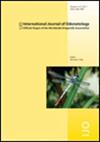秘鲁豆娘属一新种(豆娘科:豆娘科)
IF 1
4区 农林科学
Q3 ENTOMOLOGY
引用次数: 0
摘要
描述并说明了Tukanobasis huamantincoae sp. n.(全型♂:秘鲁,Loreto Región [MUSM])。雄斑蝶与雄斑蝶的区别在于,雄斑蝶有突起后斑点和肱骨前条纹,顶端无棕色翅斑,节后数量较少,叶尖较短,叶脉从四边形向翼缘下降,不形成直线,翅柱头上部明显黄色,S8-10橙色/红色,尾毛弯曲较强,顶端有钝尾,生殖道舌部外侧裂片呈三角形,整体体型较小。随着对第二种Tukanobasis的描述,很明显,以前归属于该属的一些特征是种特异性的,需要更新的属特征。本文章由计算机程序翻译,如有差异,请以英文原文为准。
Tukanobasis huamantincoae, a new species of damselfly from Peru (Odonata: Coenagrionidae), with updated generic characterization
Tukanobasis huamantincoae sp. n. (holotype ♂: Peru, Loreto Región [MUSM]) is described and illustrated. Males of T. huamantincoae can be distinguished from T. corbeti by the presence of postocular spots and antehumeral stripes, the absence of apical brown wingspots, smaller number of postnodals, shorter CuA, vein descending from quadrangle not forming straight line to wing margin, pterostigma in HW distally distinctly yellow, S8–10 orange/red, cerci more strongly curved and with apical blunt appendix, genital ligula with triangular lateral lobes and overall smaller body dimensions. With the description of this second species of Tukanobasis it becomes clear that some characters previously attributed to the genus are species-specific, requiring an updated generic characterization.
求助全文
通过发布文献求助,成功后即可免费获取论文全文。
去求助
来源期刊

International Journal of Odonatology
ENTOMOLOGY-
CiteScore
2.30
自引率
0.00%
发文量
15
审稿时长
>12 weeks
期刊介绍:
International Journal of Odonatology (IJO) is aimed at providing a publication outlet for the growing number of students of Odonata. It will address subjects such as the ecology, ethology, physiology, genetics, taxonomy, phylogeny and geographic distribution of species. Reviews will be by invitation, but authors who plan to write a review on a subject of interest to the journal are encouraged to contact the editor.
 求助内容:
求助内容: 应助结果提醒方式:
应助结果提醒方式:


